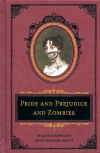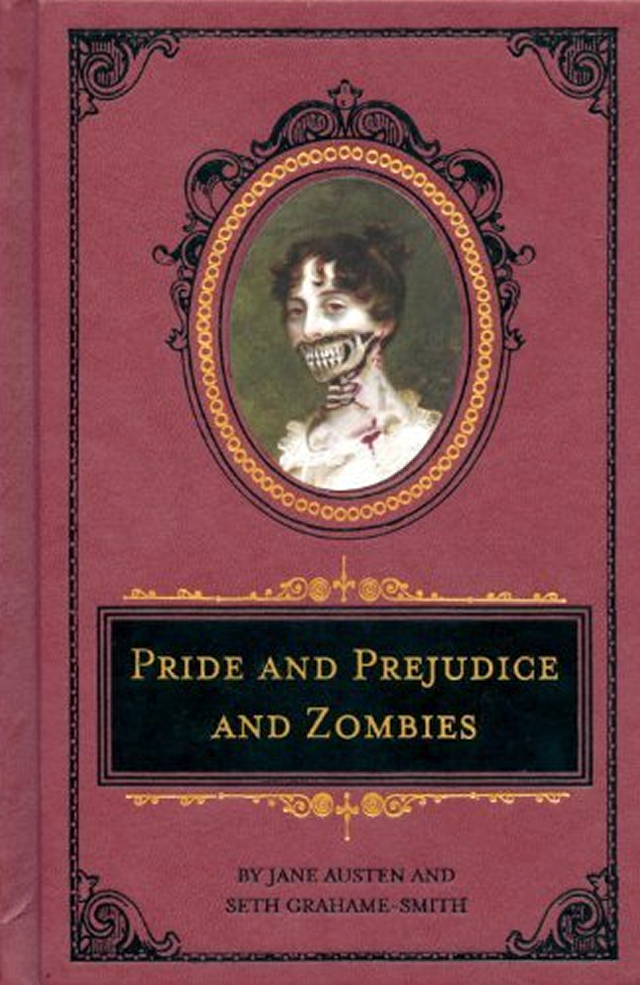
From the back cover:
“It is a truth universally acknowledged that a zombie in possession of brains must be in want of more brains.”
So begins Pride and Prejudice and Zombies, an expanded edition of the beloved Jane Austen novel featuring all-new scenes of bone-crunching zombie mayhem. As our story opens, a mysterious plague has fallen upon the quiet English village of Meryton—and the dead are returning to life! Feisty heroine Elizabeth Bennet is determined to wipe out the zombie menace, but she’s soon distracted by the arrival of the haughty and arrogant Mr. Darcy.
What ensues is a delightful comedy of manners with plenty of civilized sparring between the two young lovers—and even more violent sparring on the blood-soaked battlefield. Can Elizabeth vanquish the spawn of Satan? And overcome the social prejudices of the class-conscious landed gentry? Complete with romance, heartbreak, swordfights, cannibalism, and thousands of rotting corpses, Pride and Prejudice and Zombies transforms a masterpiece of world literature into something you’d actually want to read.
Review:
The plot of Jane Austen’s Pride and Prejudice is generally well known. Elizabeth Bennet and Fitzwilliam Darcy meet, do not get along, form incomplete and incorrect notions of each other, see the error of their ways, and eventually end up living happily ever after. To this scenario, add some zombies, toilet humor, and a whole lot of innuendo and you have Pride and Prejudice and Zombies. Except that’s not entirely true, because somehow by adding more, Seth Grahame-Smith has robbed the original of nearly every bit of charm it possesses.
The version I read was the deluxe heirloom edition, which, in evident response to criticism about insufficient zombie presence, includes “new words, lines, paragraphs, and all-new scenes of ultraviolent mayhem throughout.” The black-and-white illustrations of the original edition have also been replaced by color paintings. Judging by what I’ve seen of the former, this is a vast improvement, even though Elizabeth looks to be wearing the same white gown throughout the entire novel. In the preface, Grahame-Smith describes how he came to be involved in the project (he was unfamiliar with the novel until the idea was suggested, and this definitely shows) as well as how he wrote it by obtaining an electronic copy of Austen’s novel and inserting his own text (appropriately colored red), vowing to change at least one thing on every page. Sometimes the changes are indeed just a word here or there, and sometimes entire excursions to a nearby village to fend off some “manky dreadfuls” are shoehorned in between two paragraphs. Not content to merely add text, Grahame-Smith seems to delight in removing it, as well. Among the casualties are many of the cleverest examples of Austen’s snark, especially those that reveal character, like when Austen writes of Mr. Bingley’s sisters that they “indulged their mirth for some time at the expense of their dear friend’s vulgar relations.”
To fit the story, the characters have changed as well. Some—like Jane and Mr. Collins—manage to emerge essentially unaltered, but the leads are very different. Elizabeth is bloodthirsty, quick to consider violence as a response to dishonor, and at one point yanks out the still-beating heart of a ninja she has just defeated and takes a bite. Ew! Darcy not only has zombie-fighting prowess, he’s now a lecherous git. He’s scandalously rude to Miss Bingley, whose transparent advances he fended off in the original with implacable politeness, and often makes lewd remarks, like, “On the contrary, I find that balls are much more enjoyable when they cease to remain private.” Again I say, “Ew!” I used to adore this couple and now I don’t like either of them! Other crass (and needless) adjustments find both Mr. Bennet and Mrs. Gardiner engaged in extramarital affairs, Mrs. Bennet afflicted with recurring bouts of nerve-induced vomiting, and Wickham grievously injured seemingly for no other purpose than to allow for repeated references to his newfound incontinence.
By and large, the zombie encounters are boring and pointless. In this regard, I think Grahame-Smith might actually have been better served by altering the story even further. If the undead menace had progressed to such an extent that our protagonists were forced to undertake a final climactic battle, for example, then their presence might’ve been leading up to something. As it is, the biggest effect the zombies have on the plot is in providing explanations for the sudden departure of Bingley’s party after the Netherfield ball and Charlotte Lucas’ acceptance of a marriage proposal from Mr. Collins. Grahame-Smith invents a number of “dear friends” of the Bennets to serve as zombie fodder, but these passages—like the Christmas visit from an entire zombified family—are so embarrassingly banal I truly hope nobody reading this book without foreknowledge of the original thinks Austen’s work contained anything similar.
To sum up: this is exceedingly awful. Grahame-Smith butchers the characters of Pride and Prejudice more effectively than a horde of zombies ever could. I would almost go so far as to say that I outright hated it, but every so often, an untouched bit of Austen would shine through the muck and make me smile for an instant. Now I’m going to try very hard to forget I ever read this.


Ugh, I had managed to blank the affairs out of my mind.
What the hell?
The original had specifically noted that Mr. Bennett was not inclined to find solace in that manner. And Mrs. Gardiner.. blah.
But then, in Grahame-Smith’s bizarro world it’s the Japanese who practiced foot binding. Perhaps he can also see Russia from his house?
*snickers* I hated those affairs so much because those are the two most reasonable parental type figures Elizabeth has in her life. Mrs. Gardiner’s dalliance was particularly gratuitous and pointless.
The pointlessness is a good point. ;) The zombies were just there and not part of the plot. You’re right that it really did need a climactic battle. They didn’t have to eradicate all of the zombies. It just needed a big battle, with lives and home at stake.
I missed the reference to Japanese foot-binding. My head.
I don’t remember a Christmas visit from a zombie family.
It’s possible that the zombie family was one of the scenes added for the deluxe heirloom edition. :)
I remember the zombie baby, so I don’t think it was.
This is later, though. It’s like some family that comes calling and the girls thing they’re caroling but then they realize they’re manky dreadfuls! Oh noes! The other sisters are squeamish about killing them, so Elizabeth dispatches them all.
Ohh! Yes, I think that must have been new, you’re right.
I’m not sure caroling at that time would have been normal, either… more poorly researched cultural insertions.